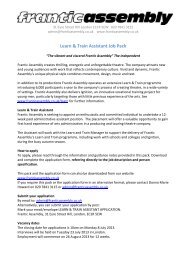Stockholm Resource Pack - Frantic Assembly
Stockholm Resource Pack - Frantic Assembly
Stockholm Resource Pack - Frantic Assembly
Create successful ePaper yourself
Turn your PDF publications into a flip-book with our unique Google optimized e-Paper software.
<strong>Stockholm</strong> Syndrome<br />
<strong>Stockholm</strong> Syndrome can easily be researched. Any search<br />
engine will quickly provide you with links to the basic<br />
background information.<br />
Although the syndrome has probably always existed it takes<br />
its name from a heist at the Sveriges Kreditbank in<br />
<strong>Stockholm</strong>, Sweden, on the 23rd of August, 1973. Two<br />
armed ex-convicts kept four bank employees captive for six<br />
days. What captured the world’s attention was the fact that<br />
when it came the captives resisted the rescuers attempts to<br />
free them. A bond had grown between captors and the<br />
captives. One of the female captives even became engaged<br />
to one of the convicts after release.<br />
This extreme behaviour fascinated psychologists who<br />
eventually christened this kind of human response<br />
<strong>Stockholm</strong> Syndrome. It has been applied to people in<br />
abusive relationships, in the armed forces as well as people<br />
in kidnap situations. It is obviously the domestic situation<br />
we are interested in here.<br />
The ways in which <strong>Stockholm</strong> Syndrome can take hold are<br />
laid out in Ramit Sethi's very clear paper 'Kidnapping the<br />
Mind’ <strong>Stockholm</strong> Syndrome Examined.' I have highlighted,<br />
in bold, the ways in which these stages correspond to the<br />
lives of Todd and Kali.<br />
1. Hostages begin to identify with captors as a<br />
defensive mechanism<br />
Because I can't stand my parents for fucks sake!<br />
Because I hate how they treat you!<br />
Because I want to be with just you on<br />
my birthday (p.48)<br />
2. Rescuers become part of the outgroup<br />
I am not going to let that mad bitch ruin our day!<br />
(p.29)<br />
3. Personal bond grows with captors<br />
Dearest darling beautiful wonderful thing<br />
Do you know how much I love adore lust<br />
fantasise want need have to have must have love<br />
passionately eternally perpetually love you desire<br />
you want you (p.43)<br />
There is simply no way of telling anyone outside<br />
of this<br />
How attractive it is true remorse<br />
Because it is real<br />
She feels it from the bottom of the heart... (p.70)<br />
It should be noted that this is all inspired by the survival<br />
instinct of the 'victim'.<br />
What results is an alienation of the people who might be<br />
able to intervene. In <strong>Stockholm</strong> there are the unanswered<br />
messages on the home phone. The tone of each (Louise<br />
apart) suggests that the caller is aware that they risk<br />
further alienating our couple. The parents especially are<br />
walking on eggshells.<br />
Are you alright, Todd<br />
Why don't you drop in Just for coffee or<br />
something...<br />
Bring Kali... both of you be lovely to see both<br />
of you... (p.74)<br />
<strong>Stockholm</strong> Syndrome can leave the 'victim' with a<br />
fascinating justification for this alienation. The example<br />
Ramit Sethi gives is<br />
'I want to live but if the FBI kicks down the door,<br />
they might shoot me or make my captor shoot<br />
me. In fact, if it weren't for the FBI surrounding<br />
this building, we wouldn't be in this situation'<br />
This transference of blame and denial, coupled with the<br />
genuine love they must feel for each other keeps this<br />
couple coming back for more and keeps their friends and<br />
family at bay.<br />
See Kidnapping of the Mind: <strong>Stockholm</strong> Syndrome<br />
Examined by Ramit Sethi - www.ramitsethi.com<br />
4. Emotional distancing and denial of situation<br />
It’s like getting to the summit of the<br />
medium-difficult climb<br />
the violence then the after is the best bit (p.69)<br />
...her playful punching of the six-pack she is so<br />
proud of calls forth a pain similar only to an<br />
uber-tough exercise regime (p.69)<br />
4<br />
Samuel James and Georgina Lamb<br />
Photo Sandro Martini
















